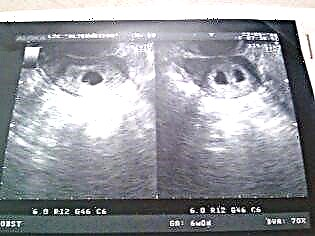
An ultrasound examination in early pregnancy is carried out only for strict medical reasons. At 4 weeks, the fetus is actively growing and developing. With the help of ultrasound, it is possible to detect not only pregnancy, but also to determine the primary anomalies of its course and development.

What does the study show?
3-4 weeks of pregnancy is a very important stage in organogenesis. At this time, the laying of vital organs occurs. During such a period, doctors call the future baby embryo. In its size, it reaches only a few millimeters.


It is important to note that doctors determine the obstetric gestational age to assess the intrauterine development of the fetus. The expectant mother will subsequently face this medical term throughout the entire period of bearing the baby.
Some doctors also use the concept "Embryonic term". It should be noted that embryonic development lags behind obstetric development by a couple of weeks. This is due to the fact that the obstetric period is counted from the estimated date of the last ovulation and conception by 2 weeks.


In order not to get confused with the terms, doctors recommend that expectant mothers use those that they use in their work. Moreover, in the future obstetric gestational age will appear in the medical records of a pregnant woman much more often.
At this time, the active development of the embryo takes place. At this time period of pregnancy, a small embryo is only a group of actively dividing cells. It usually has a three-layer structure. Subsequently, these layers will be transformed into the development of fetal structures. At this time, the rudiments of the brain, spine, gastrointestinal tract, future skin and other internal organs are actively formed.

Chorion is an actively developing anatomical structure. It is necessary for the blood supply to the fetus. Chorionic blood vessels in this case grow strongly to the inner lining of the uterus.
Through this communication, the fetus receives all the necessary nutrients and oxygen dissolved in the blood. Also, the placenta will be formed from the chorion in the future.


By the end of the fourth and beginning of the fifth week of pregnancy, it begins to form amnion... This is a formation, inside which the embryo itself and the fluid component are located. In the future, fetal membranes and water will form from the amniotic sac.
Yolk sac Is another important anatomical structure of the embryo. It is the rudiment of the formation of some internal organs in the future. At this time, the size of this formation does not exceed a few millimeters. It is important to note that only experienced ultrasound diagnostics specialists can determine this anatomical structure.


What is it for?
Conducting an ultrasound scan at the earliest stages of pregnancy is more the exception than the rule. Absolutely all women do not do such research. At this time, the size of the embryo is so small that the doctor can accurately and not establish them.
4th week of pregnancy is the time when it is determined fact of pregnancy, as well as concomitant diseases of the internal genital organs of the expectant mother. It is important to note that such an examination plays a very important role in drawing up further tactics for managing the patient.

Ultrasound can also be performed in multiple pregnancies, when the expectant mother is expecting the birth of twins or triplets. A fertility specialist can also prescribe this study to establish the result after in vitro fertilization. In this case, in the uterine cavity, the specialist conducting the ultrasound will see several gestational (fetal) eggs, which will indicate a favorable outcome of implantation.
It is also necessary to conduct research at such an early stage. to establish signs of ectopic pregnancy. In this case, the ovum in the uterine cavity is not visualized. The high blood level of hCG in this condition only confirms the presence of an ectopic pregnancy.
Doctors can also prescribe such a study if there is a suspicion of trophoblastic disease. This disease can lead to spontaneous miscarriage or the formation of intrauterine malformations.


Also, ultrasound diagnostics helps to identify various cysts of the corpus luteum, which also quite often develop during pregnancy due to altered hormonal imbalance.
Usually screening in the first trimester of pregnancy is carried out much later - at 10-12 weeks. In this case, you can already better consider all the anatomical structures of the fetus. Also, at this time, doctors can determine various pathologies of intrauterine development.
Norms of the studied parameters
The small size of the embryo still does not allow ultrasound diagnostics specialists in this period of pregnancy to determine all of its internal elements. The future baby at the 4th week of its intrauterine development usually looks like a poppy seed. Its longitudinal size at this time is 1-1.5 mm. By weight, it is even less - about 0.6 grams.


The main anatomical element that is determined by doctors of ultrasound diagnostics at this stage is the fetal sac. It is a formation located on the inner wall of the uterus. The size of the fetal sac is usually 3-5 mm.
4 week is also the time when all the indirect signs of pregnancy are perfectly manifested. During this period, doctors determine the expansion of the blood vessels of the uterine vessels. This phenomenon occurs due to the fact that the growing embryo requires more nutrients and oxygen for its active growth and development.
At this time, the size and tone of the uterus are also determined. The growing embryo and the action of pregnancy hormones lead to the fact that the size of the genital organ gradually begins to increase. The size of the cervical canal is also determined. Normally, it should not be less than 3 cm. If its shortening is determined, then in this case, this patient must definitely consult a gynecologist for a second consultation to exclude ICI.


There are several ways to do early research. The most common is transabdominal. In this case, the study is carried out through the anterior abdominal wall. The doctor touches the skin with a special ultrasonic sensor, and an image appears on a special screen.
To obtain the best picture, a special transparent substance is used. This gel is pre-treated with the skin of the abdomen. It is necessary to improve the penetration of ultrasonic waves into the body.
Many pregnant women believe that this gel can be dangerous. However, this is not at all the case. Its hypoallergenic composition completely excludes the occurrence of any allergic reactions in expectant mothers. After the examination, the gel is removed with a regular paper towel.

Another way to get the image on the screen is use of transvaginal ultrasound... In this case, the doctor conducts a study using a special sensor that is inserted into the vagina. Most doctors consider this method the most accurate and informative, especially at such early stages.


It is important to note that doctors identify several contraindications for performing a transvaginal ultrasound. If a pregnant woman has an exacerbation of colpitis or vaginitis, then most likely this examination will be postponed. In such cases, doctors replace transvaginal ultrasound with a transabdominal examination.
During this examination, the doctor can take the first pictures of the baby. On such an image, it is still impossible to distinguish the contours of the body of the unborn child. This picture shows only a rounded or elongated formation. In some cases, the first "photo" of the child is taken at the request of the expectant mother.


If, after the ultrasound scan, the doctor did not reveal any signs of pregnancy, but the woman still has a fairly high level of pregnancy hormones in her blood, then she is re-examined after 1-2 weeks. This situation quite often occurs when an ectopic pregnancy is difficult to diagnose. Also, such a case may be the result of a "frozen" or "frozen" pregnancy.
Is it possible to do on such terms?
Early ultrasound examination is an exception, not a mandatory practice. The first regulated period for this examination is 10-12 weeks of pregnancy. It is at such a time that an ultrasound scan can identify all the specific pathologies of bearing a fetus and evaluate its intrauterine growth.

Frequent ultrasound examination, especially in the early stages of fetal development, will inevitably lead to adverse consequences. Scientists from many countries annually conduct hundreds of scientific experiments that determine the negative effect of ultrasound on the developing fetus after the abuse of ultrasound in pregnant women.
4 week is the time of maximum intensive growth and organogenesis of the fetus. The action of ultrasonic waves has a mechanical external effect. This contributes to the fact that the embryo can form various abnormalities in its intrauterine development.

An ultrasound scan is performed at this time only for strict medical reasons. Doctors in such a situation mainly conduct this study in order to exclude spontaneous miscarriage or ectopic pregnancy. It is especially unfavorable to conduct research in focal mode. Doctors note that 3D and 4D ultrasound should not be performed at this time either.

The mom-to-be should remember that suspicion of pregnancy at this time is not a 100% reason for an ultrasound examination. In order to confirm the pregnancy, in this case, doctors use some laboratory tests and perform a clinical examination. In the absence of contraindications, an ultrasound scan should not be done at 4 weeks of pregnancy, so as not to harm your unborn baby.



